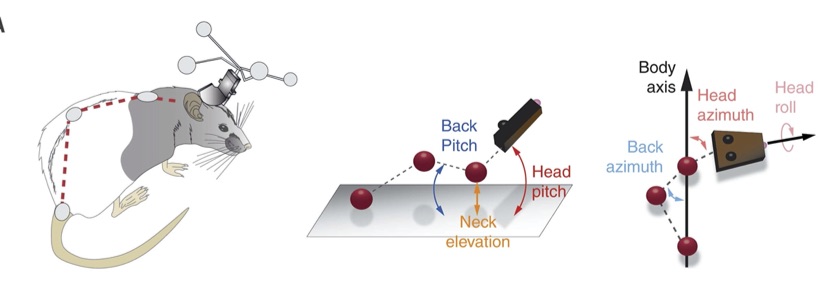Movements of our head are a synthesis of three vectors of articulation:
- Front to back movement as in a “Yes” motion.
- Left to right as in a “No” motion.
- Tipping the head side to side as in touching the shoulder with the ear.
Each of these movements has a distinct evolutionary origin, understood best in the context of our origin as four-legged vertebrates. Visualizing ourselves on all four limbs (with our eyes emerging from the top of our heads): the “Yes” motion is up/down; the “No” motion is a rotation around the head’s central axis; the tipping of the head is left/right motion. The “Yes” and tipping motions are more ancient in origin and relate to our Vertebrate neurophysiology. The “No” motion evolved more recently, requiring more complex structural and functional mechanisms (rotation around the axis of the spine), and emerged with our Mammalian neurophysiology.
The nerve supply of the muscles supporting the head in the “Yes” and tipping motions validates these statements. The nerve supply for these muscles, the Sternocleidomastoid, and Trapezius, unique to our locomotor neurophysiology, do not emerge from our spine, but rather from the Brain Stem in Cranial Nerve 10 (Vagus Nerve). This infers that their motor function is so intrinsic and ancient in animal neurophysiology (the ability to point the head to create and express intent) that they predate or co-evolved with the emergence of vertebrates. Exercises and therapies focused on these muscles in their role in head orientation have proven efficacy in improving the self-regulation of primal protective responses (the paper on Contraction/Freeze discusses this).
The first two cervical vertebrae are included in these discussions, as the base of the skull and these vertebrae function as a unit to orient the head to intent. These two bones, and the base of the skull, form a key nexus in Vertebrates. Their role is so elemental to movements of the head they are individually named: Axis (C2) and Atlas (C1). Together with the base of the skull, they facilitate complex movements in three dimensions. These movements are related to specific sensory/processing/structural roles that emerged sequentially in our ancestral evolutionary journey:
- The more evolutionarily ancient role relates to forward movement and vision. In our physiology these are the nodding “Yes” and tipping the head to the ear movements:
DISCUSSION OF THE ATLAS/OCCIPUT AND VISION - The more evolutionarily recent role relates to the vestibular system (sense of balance) and auditory awareness of the surrounding space. In our physiology this is our nodding “No” movement:
DISCUSSION OF THE ATLAS/AXIS AND HEARING/VESTIBULAR SYSTEM
THE ROLE OF POSTURE IN MOVEMENT
The complexity of the integration of sensing and sensory processing as it relates to movement and motor planning is explored in this paper:
THE ROLE OF POSTURE IN MOVEMENT
Efficient cortical coding of 3D posture in freely behaving rats
These findings support the premise that our head position relative to our torso is a core mechanism supporting our awareness of our position in space relative to the space surrounding us, and the posture we present to that awareness.

/Therapies for the head in the context of this model
META READING
Overview of discussions on our head:
HEAD
Overview of discussions on our locomotive core:
LOCOMOTIVE CORE
Overview of discussions on our core neurophysiology:
THE FOUR CORES
Overview of models presented on this site:
MODELS